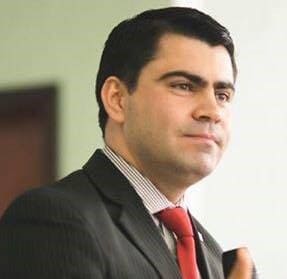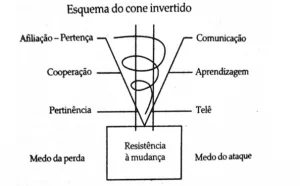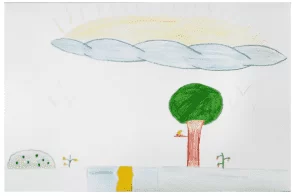ORIGINAL ARTICLE
SANTOS, Mauro Ribeiro dos [1]
SANTOS, Mauro Ribeiro dos. Coaching: A brief historical, conceptual and practical analysis of the method. Revista Científica Multidisciplinar Núcleo do Conhecimento. Year 05, Ed. 07, Vol. 04, pp. 171-195. July 2020. ISSN: 2448-0959, Access link: https://www.nucleodoconhecimento.com.br/psychology/brief-historical
SUMMARY
In recent years coaching has stood out as an attractive option to develop skills of people linked to corporate and business environments. There are also coaching modalities aimed at personal development in the most varied areas of life. The aim of this article is to explore coaching, taking into account its concepts, history and tools, highlighting its relevance in the emotional and practical formation of people linked to both the corporate environment and other environments where its application is deemed necessary. Thus, this article presents, in detail, the main topics about coaching aiming to develop a reflective process based on historical and methodological study, as well as the analysis of tools commonly used in coaching sessions, which in turn aim to raise awareness of the current state of coachee, the formatting of an action plan and decision-making with a view to achieving the pre-established goals. Thus, this article highlights, using considerable theoretical reference, the conceptual and paradigmatic evolution of the modern conventional coaching scheme.
Keyword: Coach, coaching, tools, leadership, management.
1. INTRODUCTION
The competitiveness of the corporate world requires objective strategies to achieve goals and a clear vision of the future to achieve the expected results. For this, more than ever, it is necessary that there are trained collaborators, with emotional and relational skills who can guide their own steps and also their leaders so that the institutional mission is successfully achieved. These skills or competencies, when not developed, can compromise the direction of business and even stagnate extremely important activities. In this perspective, special attention is needed to train human resources in order to develop the necessary skills with a focus on the desired results.
When talking about human resources development, we soon think of the conventional: lectures, workshops, seminars, workshops and other forms of knowledge transmission that are commonly used in people management for the improvement of individuals and organizational teams. However, research shows that this training configuration does not always achieve measurable and lasting results. According to Bitencourt (2004) traditional training no longer responds to people’s training needs. Therefore, an updated approach is needed that responds to the expectations of an increasingly informed public with varied needs.
In his book entitled Gestão de Pessoas, Gil (2007) presents people with many differences between them. According to the author, one of the most important aspects of the study of human behavior are individual differences. He points out that because people are different, they need to be treated and developed in different ways as well.
For Gil (2007, p. 287) people are interdependent, they need each other for their development. Even to know who they really are and what choices and decisions should be made, the relational experience is extremely relevant. He comments: “In this sense, the coach can help them form an appropriate image of themselves by developing confidence in their possibilities. Even if competent people need to be heard, recognized and valued.” Thus, this article seeks, through bibliographic research, to situate the coaching methodology historically, conceptualize it, and describe the main tools used throughout the process.
2. GENERAL COACHING CONCEPTS
According to Celestino (2015) Coaching is a process of skills development. Thus, coaching is understood as a methodology of people development that occurs through a process in the short, medium and long term. “In reality there are several definitions and concepts of coaching, and there is no consensus among scholars of the theme” (BATISTA, 2013. p. 24).
For Marion (2017, p. 5) “coaching works as a partnership relationship. This relationship takes place between the coach, who is the one who applies the coaching process, and the coachee, the one who receives the coaching”. According to Stoltzfuz (2015, p. 20) “coaches are experts in change that help leaders take responsibility for their lives and take actions to maximize their own potential.” For the International Coaching Federation (IFC) (2019), “professional coaching is a partnership with the client in a thought-provoking and creative process that inspires them to maximize their personal and professional potential”.
According to John Whitmore (2009 cited by MARION, 2017, p. 3), one of the most influential characters in this methodology, “coaching is a process of change and transformation focused on future possibilities and not on past mistakes”. For Whitmore, the essence of coaching is change and transformation. Coaching plays the role of supporting anyone from the infinite and future possibilities. (MARION, 2017).
For a more detailed conceptual analysis, follow the table below:
Table 1 – General Coaching Concepts
| Authors | Concepts |
| Sztucinski (2001) | Coaching is a helping relationship between an executive and an external coach. The purpose of the relationship is to facilitate the desire of the executive (coachee) to achieve goals related to professional development and essentially, with the result of the organization. |
| Dingman (2004) | Coaching is a supportive relationship between an executive with authority and managerial responsibilities in an organization and a coach. The coach makes use of a process that facilitates the executive to achieve personal and organizational results. |
| Blanco (2006) | Coaching is characterized as a collaborative integration process focused on the promotion and stimulation of learning. The goal is not to teach, but to help the other learn. |
| Mayard (2006) | The coach’s activity is from a process facilitator, promoting support and encouragement. Coaching is a process of practical guidance that promotes personal and promotional development through self-promoted changes, differentiating from therapy by its orientation to a non-clinical population (which seeks immediate improvement in their well-being or cure in situations that require therapeutic intervention). |
| Ting and Scisco (2006) | Executive coaching helps leaders better understand themselves, so they begin to explain their strengths and help them more effectively and intentionally, developing the identified needs and the as yet untested potential. Much of the coach’s work involves helping coaches gain clarity about their motivations, aspirations and commitment to change. |
| Clutterbuck (2007) | Coaching is an activity done with someone and not for someone. The responsibility of making this process work is shared between the coachee and the coach. Both need to show conduct of trust and openness, essential to establishing bonds between them. |
| Matta (2008) | Coaching is a process that aims to increase the performance of an individual (group or company) by increasing positive results through scientifically validated methodologies, tools and techniques, applied by a qualified professional (the coach), in partnership with the client (the coachee). |
| Underhill and Mc Anally (2010) | The purpose of executive coaching is the development of the skills of the leader, who has a formal position or not, in the most diverse organizations; large or small enterprise; with or without profit; government or public. |
Source: Adapted from Batista (2013, p. 27).
The table above presents, according to the conceptualization of several theorists, the main descriptions of the coaching process as used today. These concepts contribute to a greater deepening of the minutiae of this methodology, which has as main foundation to develop a clear vision of the future and a plan for carrying out actions that help people achieve their goals.
3. SOME COACHING INTERFACES
Coaching presents some interfaces with other processes developed inside and outside companies. However, there are clear differences between coaching and psychotherapy, counseling and training. The table below summarizes these differences showing the distinctive aspects of coaching in relation to its personality, agility, focus on the future, deep relationship, rapid action and its tools of personal discovery, while the other types of processes mentioned, which clearly have their relevance, are focused on the past and in deep clinical treatment, operational direction and collective training in search of corporate goals.
Table 2 – Coaching Interfaces
| DIFFERENCES – COACHING X PSYCHOTHERAPY-COUNSELING-TRAINING | ||
| COACHING | Psychotherapy | |
| 1. Focused on professional and personal performance. | 1. It focuses primarily on the individual and his/her personal problems. | |
| 2. Emphasis on the future. | 2. Greater emphasis on the past. | |
| 3. Fast and Superficial. | 3. Long and deep. | |
| 4. You worry about what’s missing. | 4. You care about what’s wrong. | |
| 5. It’s aimed at action. | 5. It aims at changing the personality. | |
| Coaching | Advice | |
| 1. It is intended for any employee. | 1. It is intended for employees who have problems. | |
| 2. Less direct. | 2. More direct. It seeks to draw the person’s attention to the problem. | |
| 3. Provides elements for which the descent client is to change. | 3. It seeks to make the person recognize the need to change. | |
| 4. Seeks to know possible alternatives to improve performance. | 4. It seeks to identify the cause of the problem and reinforce the correct behavior. | |
| Coaching | Training | |
| 1. It’s individual. | 1. Typically targeted at groups | |
| 2. Objectives are defined throughout the process. | 2. Works with defined and operational objectives | |
| 3. A more frank and intense relationship is required than in training. | 3. The relationship is not close. | |
Source: Adapted from Gil (2007, p. 284).
According to Gil (2007, p. 284), “although psychotherapy is no longer an activity confined only to offices and has been used more and more in companies and other environments where it is considered its need, there is a great difference between the two follow-ups”, as described in Chart 1. In the coaching process, unlike psychotherapy, the solution of problems or achievement of future goals is emphasized. It will not be the professional who will give the diagnosis, but the process of personal reflection itself. Similarly, the training-coaching relationship stands out, which even having a nomenclature that is consistent with the idea of “training”, the coaching process has a great methodological difference in relation to conventional training, especially those that are performed with large groups. In group training, the focus, in most cases, is on the operational, that is, on how to integrate actions in a corporate way so that an institutional goal can be achieved. The example is: training of new software, closing sales, customer service or training of internal administrative processes, among others. In coaching the deal and goals are set individually. And even if the coaching process is directed to a group, such as the team coaching format, as we will see later, the process is individualized.
Counseling has many characteristics of psychotherapy and has a few elements of coaching, such as the development in advising a necessary view of change. But according to the methodological guidelines of coaching, actions should be guided by the coachee and not through guidelines and advice. In counseling it is assumed that the counseling has a problem, whether personal or professional, and therefore needs a direction to achieve solutions, which in this case is given by someone more experienced or with a certain degree of leadership who acts showing a path to be followed.
Another process widely used in the corporate environment is mentoring. According to Gil (2007) it also has some similarities with coaching but its philosophical basis is completely different. In the mentoring process few people are chosen for follow-up. Most of the time they are employees with a lot of potential and that prove promising. Unlike the coaching process, in mentoring the professional chosen for the follow-up will always be some who already have great professional experience and who by the know hall that has full conditions to mentor someone less experienced for a certain responsibility.
4. SOME TYPES OF COACHING
Even with a strong initial connection with the sport, the coaching methodology is currently extremely comprehensive with specific methods and concepts practiced in various segments. Below is briefly highlighted some types of coaching and their functions.
4.1 LIFE COACHING
According to the Latin American Coaching Society (SLAC, 2012) Life Coaching is carried out with the aim of helping coaches (clients) to develop everything that is essential in their life journey. Society cites, for example, health, work and satisfactory relationships. Life Coaching involves supporting the person to discover, create and sustain their dreams. Life coaching must build a bridge from where the person is, that is, tip “A”, to the place where he wants to reach in his personal life, point “B”.
For the Brazilian Institute of Coaching (IBC) (2016) Life Coaching uses the methodology as a philosophy of life. As a style of communication that allows you to break the limiting beliefs, achieve the goals and have a better quality of life. For Lopes (2016) Life Coaching focuses on aspects that go beyond the professional. It is not therapy, although it helps in the search for personal goals, such as running a marathon, relationship change or even time management.
In Life Coaching the focus is on personal development. Through questions that generate reflection the coach conducts the process extracting from the coachee the answers to his own questions, helping him to establish goals and work so that they are achieved as effectively as possible. In this coaching niche as well as in others, the constant and regular monitoring of the coach working the feedback and motivation is extremely important.
4.2 CAREER COACHING
The Brazilian Federation of Coaching (FEBRACIS), (not dated) on its website presents career coaching as an aid for people to discover and explore a professional career that suits its characteristics and even help in a professional transition through a process that explores a wide range of possibilities until the moment of discoveries. The process also acts in the development of relationship skills, time management, leadership, increased focus on goals and desired results.
On the website of the Latin American Coaching Society (SLAC), information about research conducted in 2010 was published. The figures presented provide the basis for affirming the great need of the Career Coach in the current scenario of the labor market.
A survey was conducted in 2010 with 435 people among executives, leaders, managers and students, which pointed out a large number of professionals dissatisfied with their careers. Among the interviewees, 43.4% were convinced that they were not satisfied with their career and 8.8% said they were satisfied but could change jobs at any time. (SOCIEDADE LATINO AMERICANO DE COACHING, undated)
According to the Brazilian Academy of Coaching (ABRACOACHING) (2014), the Career Coaching process is aimed at those people who have doubts about their profession and are dissatisfied with their careers. Like this, we mention people who are beginners in a career, in career transition, in the relocation phase of the market, who dream of a new profession or position, among other cases.
There are eight stages worked in the Career Coaching process, according to Costa (2015) quoting Marques (2012):
1st Meeting: The coach asks what are the professional guidelines of the coachee and what he would like to achieve. 2nd Meeting: The two set realistic goals and make an analysis of where the coachee is on their walk. 3rd Meeting: The coach makes a map of the coachee’s network of relationships and how his networking will help him put himself in the desired position. 4th Meeting: The coach discusses the expectations of the coachee’s value. 5th Meeting: The two define a focused action for the goal to happen. 6th Meeting: Analyze the competitiveness of the market. 7th Meeting: Determine the actions and competencies that the coachee does not have. 8th Meeting: It is analyzed what was done in previous meetings and what remains to be done to achieve the objectives. In this meeting the coachee leaves with a planning of what he should do in the next six months. (COSTA, 2015, p. 95).
The goal in this process, according to Costa (2015), is to collaborate so that the coachee develops self-awareness that it is possible to build a successful career by being more assertive, making decisions that make sense in their professional journey, enabling a happy development that brings balance and satisfaction to the individual and all those around him.
4.3 LEADER COACH
According to Marques (2013) “the Leader Coach provides the synergistic movement around the art of co-creating, activating the potential of people to be even better, assisting in the development and improvement of their skills”. For Penido (2016, p. 106), “one of the duties of the Coach Leader is the attempt to provide continuous improvement in organizational learning, ensuring an environment conducive to the performance of the activities of professionals”.
For the Brazilian Institute of Coaching, (IBC), on the website of its president, there is a brief concept of leader coaching:
The Leader Coach unites coaching tools and practices through a humanistic methodology of accelerating results, through self-knowledge, development of skills and new skills in order to add to the leader the ideal qualities so that it plays assertively its role within the organization. (MARQUES, 2014, Non-paged)
4.4 EXECUTIVE COACHING
For Krausz (2013) the latest changes in the economic scenario demand better direction on the part of executives in their activities, for this executive coaching can collaborate, through its methodologies, awakening in the coachee an updated vision, based on relevance, helping in the discovery and understanding of the role of the executive no longer as the commander-in-chief, but as a team integrator.
Given its specificity, executive coaching gained strength and relevance from the last decade of the 20th century for its ability to meet demands generated by the rapid socio-economic transformations (sic) that impacted the business world and fundamentally altered the role of executives in a changing scenario. (KRAUSZ, 2013, p. 20)
Krausz (2013) emphasizes that Executive Coaching, in a summary, is a powerful driver at the service of leaders and organizations. Its mission is to contribute to the development of conditions that provide productive and less stressful work environments. According to the author, executive coaching encourages leaders to assume their role as multipliers of knowledge.
The Executive Coach stands out for developing talents in conjunction with the continuous training of organizations, mainly due to the current situation in which we live, where human resources are improved, requiring a lot of employees, always trying to increase income, improve time management and deliver results. Coaching contributes to better stress management and better adaptation of a work pace that is required in organizations. The success of professionals who work with coaching is based on finding new paths to certain situations. (VILLA; CAPERÁN, 2010). For the Executive Coaching Forum (2008), cited in coaching brasil magazine (2013, p. 21), “it is an individualized and experiential process of leadership development that improves the ability to achieve organizational goals in the short and long term”.
4.5 TEAM COACHING
Team coaching aims to better improve the results of a team working on performance development focusing on interpersonal relationships, tasks and attitudes that can somehow intervene in the day-to-day group activities. The goal is to make the actions of the group more consistent and that there is a constant communication in the progress of operations in the organization.
The employee coaching that is also known as team coaching, has been used by leaders in companies, aiming at the development of an activity in which the immediate superior works for the continuous improvement of employee performance, seeking the development of future skills, skills and challenges, based on the relationship between leader and leader. (FERREIRA, 2013, p. 42),
For Villa and Caperan (2010, p. 62) “team coaching meetings aim at an alignment of participants, considering the mission, vision of the organization, as well as improving the group’s performance, also collaborating to help in the transformations and business changes”. These meetings held together aim to establish a clear and operational process for the whole team, thus, mutual support and the establishment of individual goals that collaborate for the results of the group are stimulated. For the Brazilian Coaching Society (2018), Team Coaching or Team Coaching has as main objective to extract total commitment, focusing on the results that a group of people can offer. Thus, the main relevance of this coaching niche lies in the attempt to establish a vision of goal fulfillment by sharing actions of a group focused on a clear target or goal.
5. SOME COACHING TOOLS
Through a careful analysis of coaching concepts it is clear that the methodology stands out the specific questions that bring an opportunity for reflection for the coachee and the personal discovery of favorable paths for the development of performance. Allied to these questions we find in the coaching methodology some tools that, if well used, also contribute to a reflection and action to achieve the goals. According to Marion (2017), it is important to emphasize that no tool at any stage of the coaching process replaces the use of effective questions, which should be used as the main means of communication throughout the coaching process. The combination of the right tools and the right questions result in the success of the methodology. The following are a description of some of these tools:
5.1 PERSONAL VALUES
Based on Marion’s (2017) vision, the coachee’s direction for understanding and visualising her set of values is extremely important for a breakthrough in relation to the desired achievements. According to the author any construction planned for a long duration needs to be grounded on a solid foundation called personal values. A vision without values over time corrupts, empties, cools, and even loses.
For Marion (2017), it is in the deepest values that one finds a driving force to overcome obstacles and where there is strength for a constant search, he says:
Values are like inner compasses, set priorities in a choice process. They give us a sense of right and wrong, of good and bad. Values are learned during our first years of life and become rules of life that guide and guide all our decisions and choices. […] We generally express our values in abstract terms such as loyalty, freedom, adventure, friendship, challenge, integrity, responsibility, harmony, recognition, etc. Anyway, everything that is priority in our life and important in everything we do. (MARION, 2017, p. 93).
The ordering of values is a coaching tool that can be configured in various formats, privilegiem personal, professional or work environment values. The goal is the reflection of the coachee in relation to what is really important to him. Table 4 is a model of a tool for ordering values applied at the beginning of the coaching process:
Table 3 – Coaching Tool Model – Values
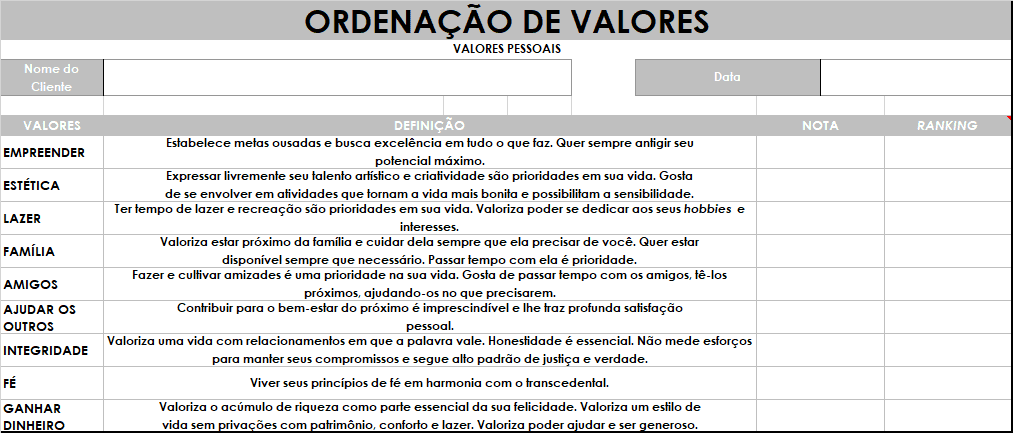
This tool model visibly enables a process of ordering personal values that guide the actions of the coachee and produce actions both in their personal and professional, educational life and so on. The knowledge of personal values brings to the coachee a better understanding of their worldview, giving the individual conditions to invest with greater intensity in areas that are already part of his moral profile achieving more satisfactory results.
5.2 360 DEGREE RATING
Another feature widely used in coaching sessions is the 360 Degree rating. Ferreira (2013), in his master’s thesis and based on his theoretical framework, states that through this instrument it is possible to elaborate a development plan considering the improvement of strengths and also aiming to minimize the weaknesses of the coachee. The use of the 360º evaluation is considered useful in the coaching process due to its ability to evaluate the before and after the process.
According to Marques (2019, not paged), “the 360 Degrees evaluation has a remarkable importance in coaching processes, although many may know this tool by itself, without seeing it being used as a complement to coaching itself.” Through it a professional makes an assessment of himself, while being evaluated by his managers, subordinates and other collaborators of the organization in which he is inserted.
Thus, in addition to understanding the vision he has of himself, the coachee will be able to know based on the analysis of third parties, how people see it, and will be able to identify difficulties and positive points that he did not know about him. This is extremely important for deepening self-knowledge and seeking new alternatives for improvement.
The next chart presents a 360-degree assessment questionnaire model. This model can be configured according to the expectations of the corporation, taking into account the main competencies required and the expected results. Thus, it is systematized in the performance research exactly what is important to know for the improvement of processes, thus enabling a reference matrix for both personal reflection and analysis of the employee’s profile.
Table 4 – Coaching Tool Model – 360 Degree Assessment
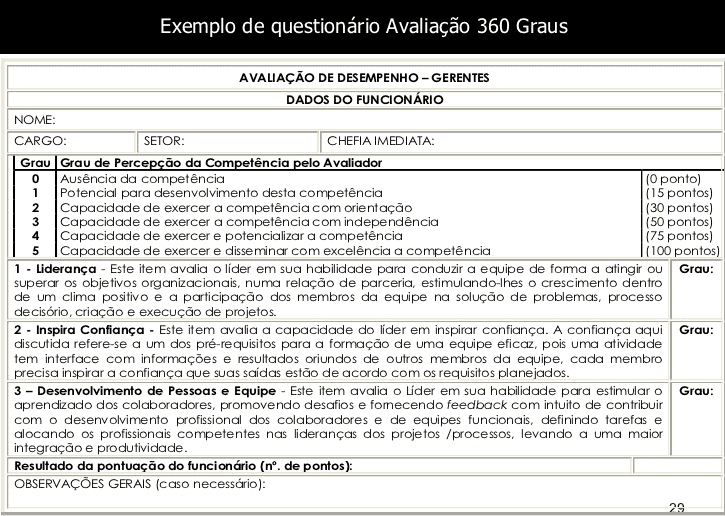
5.3 GROW MODEL
The GROW model was established by John Whitmore in 1980 and has become one of the most used by coach professionals worldwide. The model presents a didactic and simple way to perform actions throughout the coaching process. According to Stoltzfus (2014, p. 45) the acronym GROW means:
G = GOAL , R= REALITY , O = OPTIONS , W = WILL
According to the author, this progression in four stages leads the coachee through the definition of an objective, the evaluation of the current reality, the development of several possibilities of action and the creation of concrete actions with high commitment to execution. These four steps are developed through a clear, defined and relevant process highlighting the objectives to be achieved with the possibility of a deep monitoring of the processes because it is a simple and easy to perform matrix.
5.4 MATRIX SWOT
The SWOT Matrix is considered to a high degree in the area of management and planning for practicality in the visualization of environments, both internal and external, facilitating the decisions to be made. In the coaching process it is used in the early stages to diagnose reality in terms of the strengths, weaknesses, threats and opportunities that internal and external environments provide.
According to the Brazilian Coaching Society (2019), the SWOT matrix aims to provide an in-depth diagnosis that allows the elaboration of an action plan. The commonly used chart follows in the model below:
Table 5 – Coaching Tool Model – Swot Analysis
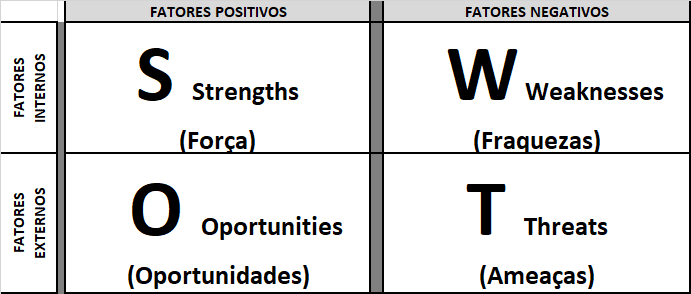
In strategic planning developed in corporate environments it is essential to know the environment for the application of the desired actions. It is always positive to start an action having full knowledge of the business context. The internal and external environment with its many characteristics must be taken into account in all decisions. This matrix was conceived so that relevant actions that meet the need of the moment, place and people are carried out. When one knows the environment the possibility of aceto in decisions becomes much higher.
5.5 5W2H ACTION PLAN
The 5W2H can be considered a checklist of specific actions that need to be developed as clearly as possible. It should be used as a map of the activities to be developed. (MARION, 2017).
According to Franklin and Nuss (2006), this tool should be understood as an action plan, where through objective questions actions should be planned and executed enabling a follow-up at all stages of the plan.
The name is due to the use of seven words in English and is widely used in management and coaching processes for simplicity and ease of use, as follows:
WHAT , WHERE, WHO , WHY , WHEN, HOW ,( brum (2013).
6. COACHING HISTORY
The term coaching, according to Marion (2014), which can be translated as “training” or “instruction, has its origin in the term “coach”, a four-wheeled vehicle pulled by animals, that is, a carriage. This was the main means of public transport until the implementation of the railways, The term “coche” derives from “Kocs”, hungarian city where excellent quality carriages began to be produced around 1450.
This means of transport became famous and began to be exported to other parts of the world. Later, around the 18th century, English university nobles transported themselves in their carriages by coachmen, called “coacher”. Here one perceives the first relationships between the coacher’s function of transporting or driving someone from a starting point to a destination, similar to the coach’s function as described and practiced today.
According to Marion (2014) around 1850 the word “coach” came to be used in the universities of England to call the figure of a “personal tutor” whose function was to help students prepare for exams. The expression “to coach” was specifically understood as preparing someone for an exam. Already in 1880 the word “coaching” began to be associated with the sports profession in its various forms. The idea of “to coach”, in this context, has its best translation as “training”, in this case an athlete aiming at his best performance. Over the years the word “coach” has been adopted to train musicians, speakers and actors so that they develop their potentials and achieve the results expected by their profession.
For many scholars the facets of coaching date back many years before the 21st century. Viki Brock (2012) weaves a short commentary on coaching in antiquity:
Eastern philosophers and former sports coaches are among the first practitioners. In the East, the focus of physical training was martial arts rather than athletics. In the West, images captured in the amphisfrom ancient Greece provide evidence that track and field coaches had played a role in Western culture for nearly three millennia As well as their counterparts in modern sports today, coaches from ancient Greece – themselves former athletes – helped six-day competitors achieve personal excellence. (BROCK, 2012, not paged).
In his book Sourcebook of Coaching History, Brock (2012) comments that Socrates in the 4th century.C. already made use of something similar to modern coaching. According to her, Socrates used questions to help her listeners reason and make decisions from truths that are found within each being. This art has been known throughout history as the Socratic Maieutics. Etymologically, maieutics originated from the Greek term maieutike, which means “the art of partejar”. According to historical accounts, Socrates was the son of a midwife and according to him his function was similar to that of his mother, that is, to deliver. But the births he was giving was known. For Socrates knowledge is within each and his main function was to help bring him out. According to the citation below, for this reason the Socratic Method or Maiêutica constitutes, according to Ravier (2015), the methodological basis of coaching.
The basic idea of Socrates’ philosophy, which has a great correspondence with coaching, is that “There is no teaching, nevertheless, what really exists is an apprenticeship”, in which knowledge is not in the coach (professional) but in the coachee (client). Through dialogue, the Socratic Method technique is created with the objective of acquiring new knowledge and thus achieving the truth of things by questioning the concepts already formed, transferred and acquired. (RAVIER, 2015, not paged).
Reinforcing Brock’s arguments about the genesis of coaching, Krausz (2007) presents coaching as something as old as humanity. Socrates highlights, through his dialogues with his disciples, described with excellence by Plato, based on truth as something present within the individual, thus practicing a style of coaching, common in his activities as a philosopher.
Brock (2012) in his studies identifies nine roots of coaching from which the existing bases are consolidated, these are: Education, psychotherapy, communication, self-help movement, theory of social systems, athletic motivation, development theories, holistic movement, administration and leadership.
In the article entitled A history of coaching, Reis (2014), master in history, points out that the roots of coaching are divided into two master roots: One is the philosophical one, in which the coach finds the main assumptions and beliefs that sustain coaching; the other is that of the social sciences, in which coaching finds the models and techniques that give the basis for the practice of coaching.
Reis (2014) appoints the French pharmacist Emile Coué (1857-1926) as someone who according to history could be embedded in the first of the roots. According to the author, based in Voyles (2014), Coué realized that if he told his patients that a certain drug would bring good results, in fact there was a great improvement in the patient’s health. Very interested in studying the power of the human unconscious, Coué began to do his research on it at the same time as greatnames like Sigmund Freud. In his studies he came to the conclusion that the unconscious plays an extremely important role in life and that it could be manipulated and altered. In a book published in 1922, he stated that it was possible to train the mind to accept more positive suggestions and devalue those negative ones. For this, he created a phrase, “every day, in every way I’m getting better and better”, which should be repeated every day as if it were a mantra.
In the 1930s onwards, the focus on the objectives advocated by Coué was united with the idea of continuous commitment to performance growth. Counselors, therapists and psychologists made the principle of coaching work, publishing articles focused on performance and management development and advising their clients on topics similar to coaching (BROCK, 2012).
The following table presents the historical development of coaching highlighting the periods in which academic growth begins with scientific publications. For Batista (2014), despite being recent, the academic rigor of coaching is rapidly on the rise, so many answers are still to come. According to Brock’s research (2012), 153 coaching books and 132 articles were published in business and psychology magazines between 2000 and 2004.
Table 6 – Coaching Development Phases
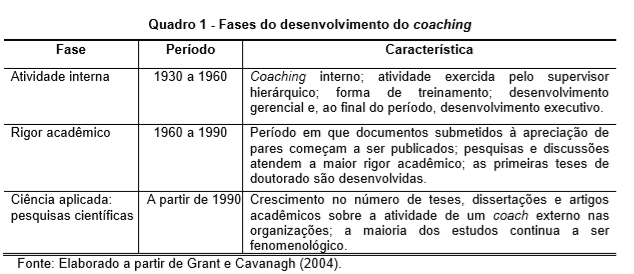
According to Bitar (2017), during the last three decades the current configuration of coaching has been consolidated through the emergence of three methodological lines or international schools. The first is The North American with a pragmatic approach, having as a precursor the American Thomas Leonard. The second line would be South American coaching, permeated by philosophical bases, had its origins in Chile having as exponents Rafael Echeverria and Julio Ollala. In the last line we have the European coaching, although created by Timoty Gallwey, his reference is the English Sir John Whitmore. It is based on a purely humanist view of phenomenology and psychology.
The coaching exercise occupies a very important position in the organizational world and already constitutes a new structured and innovative management technology for the development of organizational strategies and competencies. (ANDRADE, 2013). According to the International Coach Federation, in a survey conducted and named 2016 ICF Global Coaching Study: Executive Summary, there are 64,100 active coaches in the world considering the “spectrum of coaching” that involves both consolidated coaching professionals and managers and other leaders who use coaching skills, having as highlights in number of professionals in North America and Europe. The two continents together add up to 42,000 coaching, within the aspect. Also according to the research, worldwide revenue sums of coaching services in 2015 reached the $2.356 billion mark. The survey found that 75% of the professionals surveyed predict a significant increase in revenue in the coming years. These and other research data show the growth in the use of coaching methodologies in the global market and the optimistic outlook for the coming years.
One of the milestones in coaching history was the publication in 1974 of Timoty Gallwey’s book The Inner Game of Tennis. In this work the author – through his experiences, first as a tennis player and then as a coach – presents an important vision of how everyone in their life relationships can have a better performance with a coach, a coach, who presents a process that allows to achieve the goals.
According to Melo, Matos and Machado (2015) for Timoty Gallwey the essence of coaching is to unleash the potential of the person so that he can develop a high performance being helped to learn instead of being taught.
Gallwey presents the need for a confrontation in the mind for the potential to be developed without noise. He states that there is an internal battle in every human being that often makes it impossible for him to achieve his results effectively. For the author, self-judgment and constant memories of past actions may restrict a vision of success in the future harming the actions that must be performed in the present.
The first skill to be developed for the performance of the inner game is the consciousness free of judgments. When we stop judging, we discover, to our surprise, that we don’t need motivation to change our bad habits. We just need to be more aware. There is a natural learning and performance process. Just find it out. And this process can be very effective if carried out without interference from excessive conscious effort and its judgments. (GALLWEY, 2016, p. 47).
Gallwey when analyzing the players on the court realized that there was a constant conversation of the player with himself. Because of this, the author in his book presents the human being divided into two internal voices whom he calls “BE 1 and BE 2”. What could also be called “me” and “myself”, because when i questioned the player about who he would be talking to the answer was: “Me? Oh, with myself!”
It is not difficult to observe that the “I” and the “with myself” are separate entities. Otherwise there would be no conversation. So it can be said that in each individual there are two beings. The first is the “I”, which seems to give the instructions; the other, “with myself”, seems to perform the actions and then the I evaluate the actions performed. (GALLWEY, 2016, p. 23-24).
According to Gallwey (2016) the type of relationship that each athlete has between Being 1 and Being 2 is the primary factor in determining their ability to produce technique in effective action. In other words, the key to good tennis or anything else that needs to be improved is to improve the relationship between the conscious instructor, Being 1, and the natural capabilities of Being 2. Only when Being 1 stop judging Being 2 and his actions, can he have a better idea of his abilities and his functioning. And when this occurs confidence begins to emerge and finally becomes the basic ingredient of high performance: self-confidence.
The direction of the coach presented through reflective orientations, stimulating self-knowledge and self-learning are basic items according to Gallwey’s placements. These are also elements that underlie coaching practices and collaborate deeply in the development of people always focusing on achieving goals, knowledge of personal potential and the improvement of a clear vision of the future.
7. FINAL CONSIDERATIONS
In short, this methodological process developed, in its essence, for hundreds of years, but sumarized and recognized by the academic community for only a few decades, underscores the practices of the various modalities of contemporary coaching with the appropriate modifications, taking into account the dynamic reality of reinvention both in the area of people management and in the desire for personal improvement in a constant search for success and achievement of the goals established throughout life.
Thus, in the content presented, it was perceived the possible contributions of this methodology, currently identified as coaching, presenting a strategic option for the development of people, assisting in the improvement of a vision of both the current state of the individual and also a structured vision of the future highlighting the means necessary to achieve previously established goals and dreams, so that through a close relationship between coach and coachee sum so that all the necessary clarity for decision making can be obtained aiming at a safe walk towards the desired state.
8. REFERENCES
AMARAL, F.; Denes, R. Manual de normas técnicas e científicas da Fabapar.1. ed. Curitiba: FABAPAR, 2018.
ACADEMIA BRASILEIRA DE COACHING (ABRACOACHING) (2018). Disponível em: <https://abracoaching.com.br/coach-de-carreira/> Acesso em 26 de mar. 2020.
BATISTA, K. S. COACH: Um estudo das competências requeridas para o exercício da profissão. 2013. 113 f. Dissertação (Mestrado Profissional em Administração) – Fundação Pedro Leopoldo. Pedro Leopoldo, 2013.
BLANCO, V. Um estudo sobre a prática do coaching no ambiente organizacional e a possibilidade de sua aplicação na prática de gestão do conhecimento. 2006. 219 f. Dissertação (Mestrado em Gestão do Conhecimento e Tecnologia da Informação) – Universidade Católica de Brasília, Brasília, 2006.
BROCK, V. Introduction to coaching history. Disponível em: <http://www.vikkibrock.com/wp-content/uploads/2012/06/UTD-Coaching-News-Introduction-to-Coaching-History.pdf >. Acesso em: 04/04/2019.
BRUM, T. C. Oportunidades da aplicação de ferramentas de gestão na avaliação de políticas públicas: o caso da política nacional de resíduos sólidos para a construção civil, 2013. 72 f. Trabalho de conclusão de curso – Universidade Federal de Juiz de Fora, Juiz de Fora, 2013. Disponível em:<http://www.ufjf.br/engenhariadeproducao/files/2014/09/2012_3_Tarcisio.pdf> Acesso em: 11 dez. 2019.
CASTILHO, A. C.; SANMARTIN, S.M. Criatividade no processo de coaching. São Paulo: Trevisan, 2013.
CLUTTERBUCK, D. Coaching eficaz: Como orientar sua equipe para potencializar resultados. São Paulo: Gente, 2008.
COMISKEI, J.; SCAGGS, S.; WONG, B. Você pode ser um coach: Como ajudar líderes a desenvolver igrejas saudáveis por meio do coaching. Curitiba: Ministério Igreja em Células, 2014.
COSTA, Carlos. et al. Coaching: Aceleração de resultados. São Paulo: Ser Mais, 2015.
COSTA, R. Líderes que fazem a diferença: princípios de uma liderança que promove o reino de deus. 1. ed. Brasília, DF: Palavra, 2012.
DEIS, A. Vivências de coaching: Encantadora de vidas. São Paulo: Trevisan, 2018.
DINGMAN, M. The effects of executive coaching on job-related attitudes. 168 f. 2004. Tese (Doutorado em Organizacional LEADERSHIP) – School of leadership studies, Regente University, 2004.
FEDERAÇÃO BRASILEIRA DE COACHING (FEBRACIS). Disponível em <https://www.febracis.com.br/blog/coaching-de-carreira/> Acesso: 26 de mar. 2020.
FERREIRA, Débora Aparecida Costa, Estudo sobre a atuação dos coaches. 2013. 119 f. Dissertação (Mestrado em Psicologia) – Centro de Ciências da Vida, PUC, Campinas, 2013.
FRANÇA, S. O que é coaching de carreira. Disponível em: <https://www.slacoaching.com.br/artigos-do-presidente/o-que-e-coaching-de-carreira>. Acesso em 02 de mar. 2019.
______. O que é life coach. Disponível em: <https://www.slacoaching.com.br/artigos-do-presidente/o-que-e-life-coaching>. Acesso em: 01/03/2019
FRANKLIN, Y.; NUSS, L. F. Ferramentas de Gerenciamento. Resende: AEDB, Faculdade de Engenharia de Resende, 2006.
GALLWEY, W.T. O Jogo Interior do tênis: o guia clássico para o lado mental da excelência no desempenho. São Paulo: Sportbook, 2016.
GIL, A. C. Gestão de pessoas. São Paulo: Atlas, 2001.
______. Como elaborar projetos de pesquisa. 5. ed. São Paulo: Atlas, 2010.
INTERNATIONAL COAH FEDERATION (ICF). Sobre: ICF Definições do coaching. New York, 2019. Disponível em: <https://coachfederation.org/about>. Acesso em: 22 de mai. 2019.
KRAUSZ, R. O que é coaching? Revista Coaching Brasil, Sorocaba, SP, n. 1, p. 18-24, jun. 2013. Disponível em: <https://issuu.com/coachingbrasil/docs/revista_coaching_brasil_ed_01_junho> Acesso em: 02 jan. 2020.
KRAUSZ, R. R. Coaching executivo: A conquista da liderança. São Paulo: Nobel, 2007.
LOGAN, R.E.; CARLTON, S. Coaching para iniciantes: descubra o poder do coaching. Brasília: Palavra, 2013.
LOPES, V. A. Coaching: Modismo ou uma ferramenta de gestão que veio para ficar? Disponível em: <http://www2.al.rs.gov.br/biblioteca/LinkClick.aspx?fileticket=abmhFsTPojE%3D&tabid=5639>. Acesso em: 01 de mar. 2019.
MARION, A. Manual de coaching: guia prático de formação profissional. São Paulo: Atlas, 2017.
MARQUES, J. R. Tudo sobre coaching. WORKSHOP ONLINE DE COACHING, 2016, São Paulo. Instituto Brasileiro de Coaching. Disponível em: <http://lp1.ibccoaching.com.br/1-workshop-online-de-coaching-do-ibc-fb/>. Acessado em: 08 de Abr. 2019.
MARQUES, J. R. Coaching de carreira: construindo profissionais de sucesso. São Paulo: Ser Mais, 2012.
______. Avaliação 360º: Ferramenta de feedback e coaching (2019). Disponível em: <https://www.jrmcoaching.com.br/blog/avaliacao-360-ferramenta-de-feedback-e-coaching/> Acesso em 26 de mar. 2020.
______. O que é líder coach (2014). Disponível em: <https://www.jrmcoaching.com.br/blog/o-que-e-leader-coach/> Acessado: 26 de mar. 2020.
MATTA, V. Coaching: Excelência em performance humana. São Paulo: Sociedade Brasileira de Coaching, 2008.
MAYARD, S. Personal and professional coaching: A literature review. 2006. 135 f. Dissertação (Master of Science Psychology) – Walden University, 2006.
McGAVRAN, D. A. Understanding church growth. 3. ed. Editada e revisada por Peter Wagner (Grands Rapds Eerdmans, 1990), 123.
McANALLY, K. Coaching executivo. Para o desenvolvimento de líderes organizacionais. São Paulo: Novo Século, 2010.
MOSCOVICI, F. Desenvolvimento interpessoal: treinamento em grupo. 7. ed. Rio de Janeiro: José Olympio, 1997.
PENIDO, C. O Líder-coach e sua efetividade no processo de aprendizagem comportamental. Revista Gestão, v. 13, n. 2, p 103-115, 2015. Disponível em: <http://www.revista.ufpe.br/gestaoorg>
RAVIER, L. Coaching en Colombia: magazine coaching international. Madrid. Vol. 15, 41-43. Março, 2016. Disponível em: <https://issuu.com/leoravier/docs/15> Acesso em: 28/02/2019
______. Passado, presente e futuro do treinador: uma perspectiva pessoal sobre as origens do coaching. Disponível em: <http://www.internacionalcoachingsociety.com/passado-presente-y-futuro-del-coaching-i/>. Acesso em: 26/02/2019
RODRIGUES, N, D, A.; LAMB, L; ROCHA, C, J.; PIRES, S, M. Coaching de carreira: estudo sobre as competências demandadas por um coach. Disponível em:<https://www.researchgate.net/publication/312487829_Coaching_de_Carreira_Estudo_sobre_as_Competencias_Demandadas_por_um_Coach>. Acesso em: 03 de mar. 2019.
RODRIGUES, O. Líder coach: uma nova abordagem para a gestão de pessoas. Disponível em:<http://www.administradores.com.br/artigos/negocios/lider-coach-uma-nova-abordagem-para-a-gestao-de-pessoas/69805/> Acesso em: 03 de mar. 2019.
SOCIEDADE LATINO AMERICANA DE COACHING (SLAC). Life coaching: O coaching de vida (2015). Disponível em: <https://www.slacoaching.com.br/artigos-do-presidente/o-que-e-life-coaching> Acesso em 01 de mar. 2019.
SOCIEDADE LATINO AMERICANA DE COACHING (SLAC). O que é coaching de carreira. Disponível em: <https://www.slacoaching.com.br/artigos-do-presidente/o-que-e-coaching-de-carreira> acesso em 01 de mar. 2019.
SOCIEDADE BRASILEIRA DE COACHING (SBC) (2018). Disponível em: <https://www.sbcoaching.com.br/blog/matriz-swot/> Acesso em 04 de mar. 2019.
SOCIEDADE BRASILEIRA DE COACHING (SBC) (2018). Coaching de equipe. Disponível em: <https://www.sbcoaching.com.br/blog/tudo-sobre-coaching/coaching-de-equipe/> Acesso em 04 de mar. 2019.
SOMERS, M. Coaching em uma semana. São Paulo: Figurati, 2014.
STOLTZFUS, T. A arte de fazer perguntas em coaching: um guia de aprimoramento do coach na habilidade de fazer perguntas impactantes. São Paulo: Coach platform, 2014.
______. Coaching de liderança: as disciplinas, habilidades e coração do coach cristão. São Paulo: Coach platform, 2015.
SZTUCINSKI, K. The nature of executive coaching: na exploration of the executive’s experience. 2001. 266. f. Tese (Doutorado em educação) – graduate school of education and human development, George Washington University, 2001.
TING, S. SCISCO, P. The center for creative leadership handbook of coaching. San Francisco: Jossey-Bass, 2006.
UNDERHILL, B. Coaching executivo para resultados. O guia definitivo para o desenvolvimento de líderes organizacionais. São Paulo: Novo Século, 2010.
VILLA, J. P.; CAPERÁN, J. A. Manual de coaching: Como mejorar el rendimento de las personas. Barcelona: Profit Editorial. 2010.
WHITMORE, R. Coaching for performance: growinghuman potential and purpose – the principles and practice of coaching and leadership. 4. ed. New York: Random House Trade Paperback, 2009.
[1] Graduated in theology from UNASP-EC. MBA in leadership also from UNASP-EC and master (Stricto Sensu) in applied theology from the Baptist College of Paraná – Fabapar.
Sent: May, 2020.
Approved: July, 2020.
